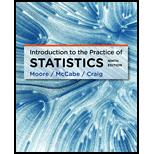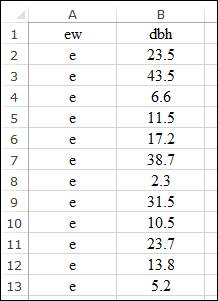
To find: The standard deviations and describe why it is a good idea to choose larger standard deviation.
Answer to Problem 113E
Solution: The standard deviations are
Explanation of Solution
Calculation: To calculate the standard deviation for four regions with reference to Exercise 7.79 and Exercise 7.80 (page 459), on excel following steps were followed:
Step 1: Open the data set for exercise 7.79. The partial screenshot is shown below:

Step 2: Write the standard deviation formula

Step 3: Write the standard deviation formula

Step 4: Open the data set for exercise 7.80. The partial screenshot is shown below:

Step 5: Go to the Write the standard deviation formula

Step 6: Write the standard deviation formula

To see the impact of standard deviation on power statistic, consider arbitrary choose some different
The power can be calculated as:
The power can be calculated as:
The power can be calculated as:
Noise is the unexpected variation in experiments. To consider their effect, it is recommended to choose larger value of
Want to see more full solutions like this?
Chapter 7 Solutions
Introduction to the Practice of Statistics
 MATLAB: An Introduction with ApplicationsStatisticsISBN:9781119256830Author:Amos GilatPublisher:John Wiley & Sons Inc
MATLAB: An Introduction with ApplicationsStatisticsISBN:9781119256830Author:Amos GilatPublisher:John Wiley & Sons Inc Probability and Statistics for Engineering and th...StatisticsISBN:9781305251809Author:Jay L. DevorePublisher:Cengage Learning
Probability and Statistics for Engineering and th...StatisticsISBN:9781305251809Author:Jay L. DevorePublisher:Cengage Learning Statistics for The Behavioral Sciences (MindTap C...StatisticsISBN:9781305504912Author:Frederick J Gravetter, Larry B. WallnauPublisher:Cengage Learning
Statistics for The Behavioral Sciences (MindTap C...StatisticsISBN:9781305504912Author:Frederick J Gravetter, Larry B. WallnauPublisher:Cengage Learning Elementary Statistics: Picturing the World (7th E...StatisticsISBN:9780134683416Author:Ron Larson, Betsy FarberPublisher:PEARSON
Elementary Statistics: Picturing the World (7th E...StatisticsISBN:9780134683416Author:Ron Larson, Betsy FarberPublisher:PEARSON The Basic Practice of StatisticsStatisticsISBN:9781319042578Author:David S. Moore, William I. Notz, Michael A. FlignerPublisher:W. H. Freeman
The Basic Practice of StatisticsStatisticsISBN:9781319042578Author:David S. Moore, William I. Notz, Michael A. FlignerPublisher:W. H. Freeman Introduction to the Practice of StatisticsStatisticsISBN:9781319013387Author:David S. Moore, George P. McCabe, Bruce A. CraigPublisher:W. H. Freeman
Introduction to the Practice of StatisticsStatisticsISBN:9781319013387Author:David S. Moore, George P. McCabe, Bruce A. CraigPublisher:W. H. Freeman





